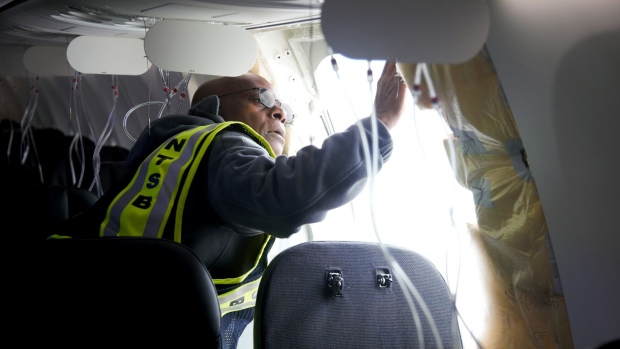Jan 30, 2024
Boeing's Dual Record Logs Eyed in 737 Max 9 Door Blowout
, Bloomberg News

(Bloomberg) -- Boeing Co.’s use of multiple record-keeping systems to log work during final construction of its 737 Max jets may have played a role in the manufacturing lapse that led to a panel exploding off an Alaska Airlines flight earlier this month.
The twin logs — one which officially tracks actions taken as the plane is put together, and another less formal one — appear to have led to confusion at Boeing’s factory in Renton, Washington, said two people familiar with the incident who asked not to be named while US investigators are still investigating the incident.
The National Transportation Safety Board is due to report preliminary findings on the accident soon. The agency hasn’t concluded what caused the near-disaster on the almost-new plane, but investigators have said they’re trying to determine whether four bolts securing the door-sized panel were installed improperly or missing altogether.
The NTSB hasn’t yet released information about the logs’ role in the accident. A finding that record-keeping played a role in the mishap would be even more problematic for Boeing after years of quality issues at the planemaker.
Inspectors at Boeing were responsible for checking that the panel, which covered an unused exit-door opening on the Max 9 jet used on Flight 1282, was properly secured before the plane left the factory.
Tracking Changes
The door plug is installed by Spirit AeroSystems Holdings Inc., which builds most of the 737’s frame at its main factory in Wichita, Kansas. Although it’s not a standard part of the assembly process, Boeing workers on occasion open or remove the panel when the plane is being assembled in its factory near Seattle, said three of the people. The panel that failed on the Alaska flight was opened by Boeing workers, one of them said.
If the panel was removed without logging that action in Boeing’s official tracking system, it could have made it less likely that quality checks were performed afterward to verify that it was correctly reinstalled, the people said.
The people cautioned that some details remained unclear and information was subject to change.
News outlets including the Seattle Times, New York Times and Wall Street Journal have reported aspects of alleged lapses in the panel’s installation, citing unnamed sources.
“As a party to this investigation, Boeing is not able to comment and will refer you to the NTSB for any information,” the company said in a statement. The company is scheduled to report fourth-quarter results on Wednesday.
NTSB spokesman Eric Weiss also declined to comment, saying the agency was “proceeding in its careful and methodical way.”
Spirit, whose workers are present alongside Boeing staff in the Renton factory, also declined to comment, citing agency rules prohibiting parties to NTSB investigations from disclosing information about agency probes.
“As a company, we remain focused on the quality of each aircraft structure that leaves our facilities,” Spirit spokesman Joe Buccino said.
The blowout led to a terrifying failure on Jan. 5 as the jet climbed, causing the cabin to lose pressure, violently sucking phones and other belongings out of the plane and subjecting passengers and crew to high winds, according to the NTSB.
Nobody was seriously injured, but the severity was apparently lessened because the failure occurred relatively early after takeoff and the two seats closest to the opening were empty, NTSB Chair Jennifer Homendy said in briefings earlier this month.
The accident led to a weekslong grounding of Max 9 jets operated by Alaska Air Group Inc. and United Airlines Holdings Inc. and prompted a steep slide in Boeing shares. The latest crisis follows a 20-month grounding of Max models following two fatal crashes in 2018 and 2019, and a string of enforcement cases by US regulators related to quality issues on various aircraft.
--With assistance from Julie Johnsson.
(Updates with results set for Wednesday)
©2024 Bloomberg L.P.


